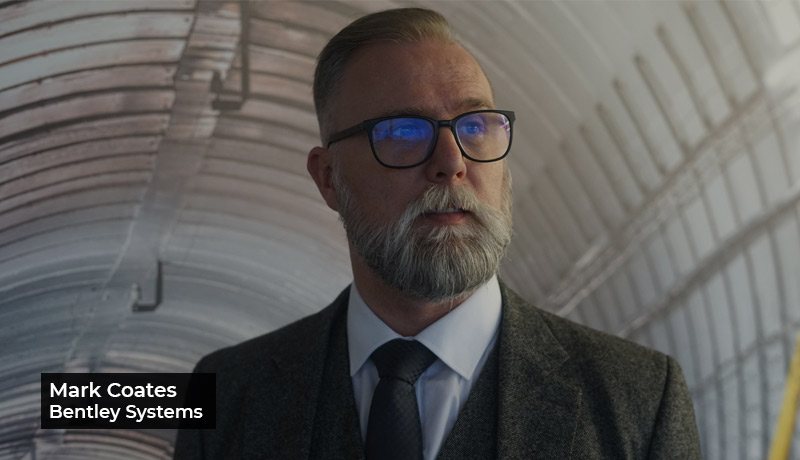
Mark Coates, International Director of Public Policy and Advocacy, Bentley Systems.
The British government believes that the data economy is crucial to the United Kingdom’s growth and future prosperity, with data benefitting the economy by up to GBP 241 billion (USD 295 billion) by 2020. In addition, the British government believes that the effective use of data could create GBP 66 billion (USD 80 billion) of new business and innovation opportunities in the United Kingdom. In the construction industry, big data refers to the huge quantities of information that have been stored in the past and that continue to be acquired today. This data can and will come from a range of people, sensors, computers, machines, and any other data-generating device.
Big data in the construction and design industry already exists in numerous silos of plans and records about everything ever built. Some of these early plans look more like works of art than the information floating around in one of today’s design offices. The data that we can now access is constantly increasing, with new and additional sources coming to the market daily. Look at places like Japan,
for example, where drones race across the sky scanning the site below, where diggers are working semi-autonomously by digging ditches or levelling previously excavated land.
It all sounds as if it is straight out of Tom Cruise’s Minority Report. However, the idea of harnessing big data for better insights and better decisions is nothing new in the design and construction industry. However, as we access significantly more data, we need more experienced analysis to draw better
and more practical project decisions. To create data, we have to capture it so that we can understand how our business processes are performing and how we can improve them.
Looking at “the big data,” on-site information on materials like steel or drainage pipes doesn’t
give a clear picture of the project status. It’s what we do with the data that counts. Look at products like SYNCHRO. Recently, FC Barcelona wanted to conduct a major renovation of its Espai Barça sports arena in Barcelona, Spain. To do so, the organization worked with SYNCHRO to recreate a cloud-based 4D construction model of the Camp Nou stadium. The model will help designers visualise the stadium upgrade and ensure that work processes are more efficient.
The project team could interact with a holographic representation of the stadium data using Microsoft HoloLens technology at any moment in the construction process and digitally track actual progress. When completed, the stadium will accommodate more than 100,000 fans.
We shouldn’t dismiss the usefulness of historical data. The information already available can be analysed to pick out patterns and probabilities of construction risk, steering new projects towards success and away from pitfalls. To create the most useful data, we need to make sure that the system collects and analyses the necessary data, instead of siloing that data, in one system – an open source. To have an open source, organizations should undertake a data audit to ensure that the useful information is captured.
Design Data:
The use of historical data will help the team guide any projects towards success and away from peril and risk by analysing and looking for certain issues, patterns, and probabilities within a
project, focusing on risks.
Construction Data:
Construction activity operates in a complex environment, especially when working in a built-up area. Collecting data that relates to traffic or pedestrian flow can help the team work out the perfect time for deliveries or certain construction activities. This information can also be analysed for fully-informed decisions on which elements of a building would most benefit from off-site construction and which elements are best left to traditional construction.
Operational Data:
Information from sensors built into assets and other forms of infrastructure make it possible to monitor anything from traffic flow and stress to pollution levels in the environment. These sensors make sure that each asset achieves peak performance and that the required maintenance is preventive not reactionary by linking the data to the BIM model. Energy conservation in public and commercial buildings can also be analysed by using sensors to see if the design actually conforms with the goals set at design stage. With some cities considering implementing their own regulatory legislation on buildings, such as New York Mayor Bill de Blasio’s proposal for certain energy-efficient standards on glass and steel skyscrapers built in the city, these sensors will become more important than ever.
With the vast amounts of data able for collection, we need to focus on what is essential and actionable. If you look at any of the surveys carried out in the last 5 years, most of the results are similar to the one shown
below: the data shows that we need to move forward.
In our recent survey, Bentley discovered that almost half of businesses (48%) still have limited or no project insight. Thus, business leaders need to ask themselves whether their business has moved on in the past five years in terms of the level of insight that’s being generated and the efficiencies that are being created.
If your business hasn’t moved on in the past five years, there’s a huge chance that your competitors have.
For those skeptical business leaders, it’s time for them to look at data again and ask themselves if their business is always working in the most efficient and effective way.